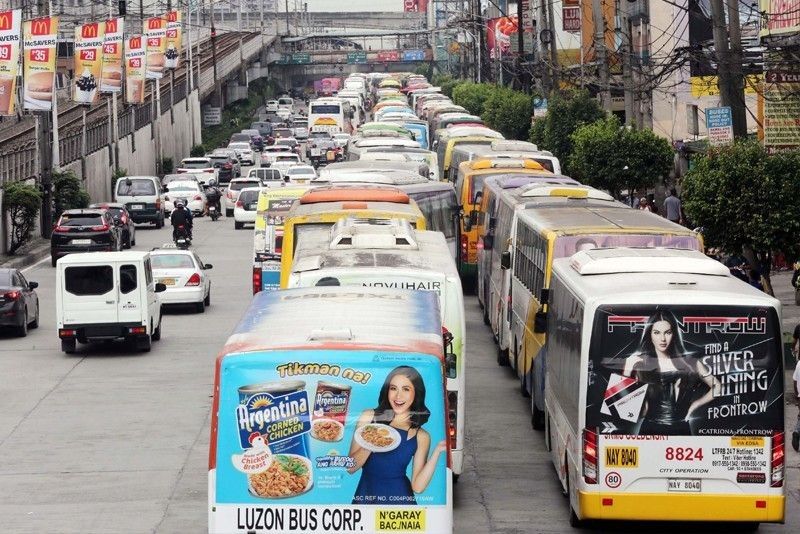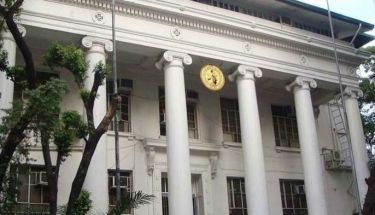House panel unveils plan to ease Edsa traffic

MANILA, Philippines — The committee on transportation of the House of Representatives yesterday unveiled its recommended blueprint to ease traffic congestion along EDSA.
Samar Rep. Edgar Mary Sarmiento said the plan calls for “a centralized and synchronized bus dispatch scheme to turn EDSA’s rowdy and chaotic city buses into a fast, efficient and predictable mass transport system.”
Sarmiento, a civil engineer, said under the plan, the innermost lane of the highway would serve as an “express bus lane” that can be accessed through stations used by the Metro Rail Transit 3.
“Like a carousel, the express bus lane will just circle around Edsa, duplicating the route of the MRT. People who use the MRT can have the option to ride the bus, which will only load and unload passengers in a synchronized manner at MRT stations so they are basically an extension of the MRT,” he said.
Sarmiento added that no traffic congestion would be created because the inner lanes from Taft Avenue in Pasay City to North Avenue in Quezon City and vice versa would be enclosed and designated as express bus lanes.
He explained that the three lanes at the middle of EDSA would be dedicated to all types of private vehicles, subject to the existing vehicle reduction programs like the number coding scheme.
Private cars would be allowed to use only the outer lane when turning into an intersection, he added.
He said the outer lane of EDSA, or the yellow lane, would be used as a dedicated city bus lane, which will also adopt a centralized and synchronized dispatch system.
“Dedicated bus stops would be established one kilometer apart. Loading and unloading of passengers will be strictly implemented,” he said.
He said while express bus lanes would cater to passengers who also use the MRT, city bus lanes would extend up to the Parañaque integrated bus terminal (PITX) in the south and the Valenzuela integrated bus terminal (VIBT) in the north.
“We are proposing this system to eradicate the kanya-kanya (each to his own) system of buses, which compete with each other creating chaos through overtaking, overspeeding, and overstaying in intersections and stops,” he stressed.
He pointed out that buses would have to move on, whether full, half-full or empty.
“The crews would no longer compete with each other, because we are recommending that they be paid salaries, instead of commissions,” Sarmiento said.
He said his committee’s recommendations would be subject to adjustments by the Department of Transportation and the Metropolitan Manila Development Authority (MMDA).
Transportation Secretary Arthur Tugade earlier supported the proposed centralized and synchronized bus dispatch system for EDSA.
Sarmiento said if the plan works, car owners might consider using public transportation instead of their vehicles.
Meanwhile, according to data from the MMDA, heavy traffic in most parts of Metro Manila is caused mainly by activity of vehicles and pedestrians, and unruly driving behavior.
The two factors comprise 18 percent each of the identified main causes of traffic congestion, according to a survey of local government units in Metro Manila by the Japan International Cooperation Agency (JICA) in February last year, which the MMDA provided this week.
Furthermore, heavy traffic is also caused by both saturated demand – or the demand a road experiences – and the practice of public utility vehicles to take and unload passengers anywhere, both at 16 percent.
Illegal roadside parking also triggered traffic congestion, added the JICA study.
The following reasons for heavy traffic were also identified: manual override of active traffic lights by traffic enforcers, or when enforcers direct traffic even with traffic lights working, at eight percent; poorly designed intersections at six percent; and inadequate signal phasing at five percent.
The MMDA and the 17 local government units in Metro Manila had also identified a total of 271 locations of traffic bottlenecks.
Most of the bottlenecks could be found in Pasig City, with 30 locations; Valenzuela with 24; 17 in Quezon City; 15 in San Juan; 14 in Caloocan; 13 in Muntinlupa; 12 in Las Piñas; and 11 in Pateros. – With Ghio Ong
- Latest
- Trending





























